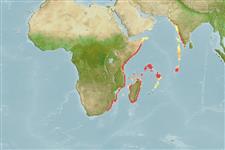Environment: milieu / climate zone / depth range / distribution range
Ökologie
seewasser demersal; tiefenbereich 60 - 260 m (Ref. 4417). Tropical
Western Indian Ocean: known only from Natal, South Africa and southwest India, but probably more widely distributed.
Size / Gewicht / Alter
Maturity: Lm ? range ? - ? cm
Max length : 26.5 cm TL Männchen/unbestimmt; (Ref. 55634); max. veröff. Gewicht: 175.00 g (Ref. 55634)
Rückenflossenstacheln (insgesamt) : 0; Rückenflossenweichstrahlen (insgesamt) : 68 - 72; Afterflossenstacheln: 0; Afterflossenweichstrahlen: 52 - 55. Eyed side with about 5 longitudinal rows of dark rings; median fins with a row of small dark spots; dark spot near margin of pelvic fin (eyed side).
Inhabits sandy and muddy bottoms.
Life cycle and mating behavior
Geschlechtsreife | Fortpflanzung | Ablaichen | Eier | Fecundity | Larven
Distinct pairing (Ref. 205).
Nielsen, J.G., 1984. Bothidae. In W. Fischer and G. Bianchi (eds.) FAO species identification sheets for fishery purposes. Western Indian Ocean fishing area 51. Vol. 1. FAO, Rome. pag. var. (Ref. 3322)
IUCN Rote Liste Status (Ref. 130435: Version 2024-2)
Bedrohung für Menschen
Harmless
Nutzung durch Menschen
Fischereien: kommerziell
Tools
Zusatzinformationen
Download XML
Internet Quellen
Estimates based on models
Preferred temperature (Ref.
123201): 18.1 - 24.6, mean 21.1 °C (based on 28 cells).
Phylogenetic diversity index (Ref.
82804): PD
50 = 0.5000 [Uniqueness, from 0.5 = low to 2.0 = high].
Bayesian length-weight: a=0.00631 (0.00393 - 0.01013), b=3.04 (2.91 - 3.17), in cm total length, based on LWR estimates for this species & Genus-body shape (Ref.
93245).
Trophic level (Ref.
69278): 3.5 ±0.4 se; based on size and trophs of closest relatives
Widerstandsfähigkeit (Ref.
120179): hoch, Verdopplung der Population dauert weniger als 15 Monate. (Preliminary K or Fecundity.).
Fishing Vulnerability (Ref.
59153): Low vulnerability (17 of 100).
Nutrients (Ref.
124155): Calcium = 171 [77, 352] mg/100g; Iron = 1.08 [0.49, 2.02] mg/100g; Protein = 16.9 [14.8, 19.0] %; Omega3 = 0.171 [0.082, 0.355] g/100g; Selenium = 70 [32, 161] μg/100g; VitaminA = 15.5 [4.1, 59.4] μg/100g; Zinc = 0.88 [0.57, 1.33] mg/100g (wet weight);
